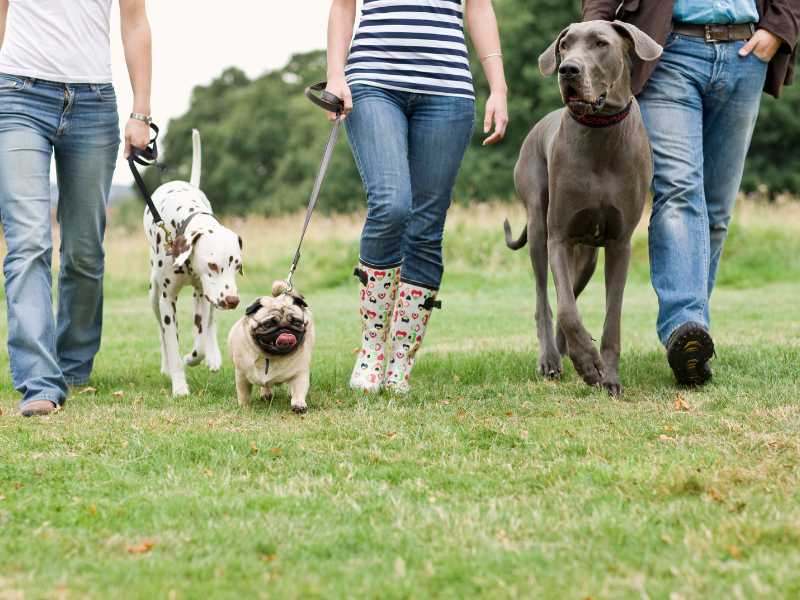
Understanding Canine Anxiety During Walks
Anxiety in dogs is a common issue that can manifest during walks. Recognizing the signs of anxiety, such as excessive panting, trembling, or pulling on the leash, is essential. Online courses emphasize the importance of understanding canine body language and behaviors to identify anxiety triggers.
The Role of Positive Reinforcement
Online dog walking courses emphasize positive reinforcement as a cornerstone technique to alleviate anxiety. By rewarding calm behaviors and providing treats for positive responses, walkers can create a more positive association with the walking experience for anxious dogs.
Gradual Exposure Techniques
Online courses guide walkers through gradual exposure techniques, helping anxious dogs become accustomed to the walking environment. These techniques involve starting with short, controlled walks in familiar surroundings and gradually progressing to more challenging areas.
Effective Leash Handling for Calmer Walks
Proper leash handling techniques are essential for managing anxious dogs. Online courses teach walkers how to maintain a relaxed grip on the leash and use gentle, steady movements to communicate with the dog. This minimizes tension and helps prevent the dog from feeling restricted or threatened.
Calming Signals and Body Language
Understanding calming signals and body language is crucial for dog walkers. Online courses delve into interpreting these signals, such as yawning, lip licking, and turning away, to gauge the dog’s comfort level and address anxiety promptly.
Creating Positive Associations
Online courses highlight the importance of creating positive associations with walking equipment, such as leashes and harnesses. By introducing these items gradually and associating them with treats and play, anxious dogs can develop a more relaxed attitude toward the walking routine.
Desensitization to Triggers
Many anxious dogs react to specific triggers, such as loud noises or other animals. Online courses teach walkers how to gradually expose dogs to these triggers in controlled settings, helping them build confidence and reducing anxiety over time.
Relaxation Techniques
Online dog walking courses cover relaxation techniques that benefit both dogs and walkers. These techniques, including deep breathing and mindfulness exercises, can help reduce stress and create a calm atmosphere during walks.
Scent-Trail Walking
Scent-trail walking is an effective technique taught in online courses to engage a dog’s natural instincts and alleviate anxiety. By allowing the dog to follow scents and explore the environment, walkers can redirect their focus away from potential stressors.
Environmental Enrichment
Online courses emphasize the importance of environmental enrichment to reduce anxiety. Walkers learn to incorporate interactive games, puzzle toys, and mental stimulation into the walking routine, providing a positive outlet for the dog’s energy.
Consistency and Routine
Consistency and routine play a significant role in managing anxious dogs. Online courses guide walkers in establishing a predictable walking schedule and using consistent cues, which can help alleviate anxiety and create a sense of security.
Gradual Socialization Techniques
For dogs with social anxiety, online courses provide techniques for gradual socialization. Walkers learn to introduce dogs to new people and other dogs slowly and positively, fostering confidence and reducing apprehension.
Communication and Bonding
Effective communication between the walker and the dog is essential for stress-free walks. Online courses emphasize building a strong bond through clear communication, trust-building exercises, and active engagement.
The Power of Play
Online courses teach walkers how to incorporate play into the walking routine. Engaging in interactive games and play sessions can redirect anxious energy and create a positive association with walks.
Managing Unexpected Situations
Anxious dogs may encounter unexpected situations during walks. Online courses provide strategies for calmly handling situations such as encountering other dogs, loud noises, or unfamiliar environments.
Seeking Professional Help
In cases of severe anxiety, online courses advise walkers to seek guidance from professional trainers or veterinarians. These experts can offer tailored advice and strategies to manage and alleviate anxiety effectively.
Case Studies: Success Stories
Online dog walking courses often include case studies of successful anxiety management. These real-life examples inspire walkers and provide insights into applying techniques to various scenarios.
Tips for Walker Self-Care
Caring for anxious dogs can be emotionally demanding. Online courses stress the importance of self-care for walkers, including setting boundaries, practicing stress-relief techniques, and seeking support when needed.
Final Thoughts: Transforming Anxious Walks
Online courses empower dog walkers to transform anxious walks into enjoyable experiences for both dogs and walkers. By applying the techniques learned, walkers can make a positive impact on the well-being of the dogs in their care.
Embrace Stress-Free Dog Walking Through Online Courses
Incorporating the teachings of online dog walking courses, walkers can confidently manage anxious dogs and create stress-free walking experiences. These courses provide invaluable knowledge, empowering walkers to understand, address, and alleviate anxiety while fostering a strong bond with their furry companions.
